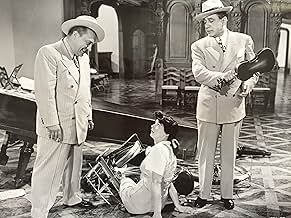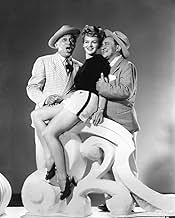NOTE IMDb
6,3/10
271
MA NOTE
Ajouter une intrigue dans votre langueOlsen and Johnson, stage comedians turned film stars, produce a star-studded musical comedy with an eccentric "millionaire" who hasn't got a dime.Olsen and Johnson, stage comedians turned film stars, produce a star-studded musical comedy with an eccentric "millionaire" who hasn't got a dime.Olsen and Johnson, stage comedians turned film stars, produce a star-studded musical comedy with an eccentric "millionaire" who hasn't got a dime.
- Réalisation
- Scénario
- Casting principal
Leighton Noble
- Johnny
- (as Leighton Noble and His Orchestra)
Sally De Marco
- Sally DeMarco
- (as Tony and Sally DeMarco)
Avis à la une
Olsen & Johnson go to Universal Studios to film their successor to Hellzapoppin', while everyone at the studio runs for cover. Since no one at the studio will back them, O&J decide to return to Miracle Pictures to get their film started. Since O&J can get no bankable stars, they decide to do the novel approach of having a film w/ new faces including singer Marjorie Nelson (who happens to catch the eye of director Ed MacLean). When films creditors find out that O&J's backer is an eccentric sort who thinks he's a millionaire broker, they put an injunction on the film, and its up to Olsen & Johnson to prove their case in court to save the film. Probably this film was on the same page w/ the WC Fields film, Never Give a Sucker an Even Break with the plot of the comedian(s) trying to film the movie. Olsen & Johnson are up to their same antics again, but after the opening scene of the Universal lot running for cover, the film can't maintain the pace of that scene or what made Hellzapoppin a laugh riot. The musical numbers are nice, but there just seems to be so many in the film, that this is a jukebox film more than a comedy. Still the film has many funny moments and is a sure treat. Rating, 7.
1943's "Crazy House" may not strike many as Ole Olsen and Chic Johnson's best film, but it's one of the highlights of their Universal resurgence in the 1940s, a gaggle of guest stars in a wacky satire of Tinseltown that would be repeated by Mel Brooks' "Silent Movie" in 1976, and "The Happy Hooker Goes Hollywood" in 1980. The picture opens with Olsen and Johnson making their triumphant return through the studio gates, or rather flying over it since studio chief N. G. Wagstaff (Thomas Gomez) made it clear that they stay locked out; they proclaim themselves 'Universal's most sensational comedy team,' and are immediately welcomed as Abbott and Costello! This is by far the most engaging part, familiar faces scrambling to escape the shadow of Olsen and Johnson, from Andy Devine and Leo Carrillo preferring the company of a skunk, to Nigel Bruce's Doctor Watson making the announcement to Basil Rathbone's Sherlock Holmes, who is already aware of their presence: "I am Sherlock Holmes, I know everything!" (the duo were currently shooting "The Spider Woman"). Nothing else comes close to this self spoofing, and six contract players include this title on their resumes without actually appearing on screen: Lon Chaney, Evelyn Ankers, Louise Allbritton, Turhan Bey, Grace McDonald, and Gale Sondergaard. Chaney would join Andy Devine and Leo Carrillo for the next Olsen and Johnson caper, "Ghost Catchers," but not their screen finale, 1945's "See My Lawyer." Today's viewers might understandably find it difficult to tell the team apart, Ole Olsen the short one with high pitched giggle, his more straight laced partner a smidgen taller.
Once the movie....in the movie--the "Crazy House" outdoor set starts; watch for the two boys licking the barber pole. The skinny, seven year old boy in the sideways striped shirt is me!!! One of those watching is Shemp Howard (in a cutaway shot). The other boy and I were having a hard time licking that barber pole; it was just dry painted wood, and even in a B&W "el-cheepo", many takes were made. Then (before the director was satisified and called, "O.K., print it); the A.D. called, "Lunch, one hour," and we walked off and around some corners to the back lot for lunch on outdoor tables. A strange event took place while we were gone and I am writing about it in a book called, "Peeping Into Hollywood." The non-fiction book takes place around 1962, when I myself was directing a film called, "BACHELOR TOM PEEPING." (Look it up on IMDB). In that book I tell many stories about my eighteen years as a child extra and sometimes bit player. Watch for the book, due out some day? The barber pole and it's aftermath is a funny, strange event.
When I was only six, my mother and father sent my older brother to
take me to watch the Olson and Johnson routine at a New York
City nightclub called THE CARNIVAL. I had been aware of the
antics of the Three Stooges, Laurel and Hardy and Abbott and
Costello, but now I could see first hand the live slapstick of
involved comedy.
The film "Crazy House" is a perfect example of keeping the wild art
of updated slapstick alive on film. It is an update of the pie
throwing of early silents and the progression from Charlie Chaplin
to Charlie Chase. This film even has small roles for all the lesser
known comics of that era. Their roles in this movie are much the
same as the bit inserts into "It's a Mad, Mad, Mad, Mad World".
For those a little bit younger than myself, this film would be called
the progenitor of "Rowan & Martin's Laugh In", a TV series that ran
from 1968-1973.
All I can say is, "If you want to see the visualization of one liners as
presented in the 1940's try and get to see this film". In the short
while, watch "Laugh In" reruns and prep yourself for a look back
into comedy history.
take me to watch the Olson and Johnson routine at a New York
City nightclub called THE CARNIVAL. I had been aware of the
antics of the Three Stooges, Laurel and Hardy and Abbott and
Costello, but now I could see first hand the live slapstick of
involved comedy.
The film "Crazy House" is a perfect example of keeping the wild art
of updated slapstick alive on film. It is an update of the pie
throwing of early silents and the progression from Charlie Chaplin
to Charlie Chase. This film even has small roles for all the lesser
known comics of that era. Their roles in this movie are much the
same as the bit inserts into "It's a Mad, Mad, Mad, Mad World".
For those a little bit younger than myself, this film would be called
the progenitor of "Rowan & Martin's Laugh In", a TV series that ran
from 1968-1973.
All I can say is, "If you want to see the visualization of one liners as
presented in the 1940's try and get to see this film". In the short
while, watch "Laugh In" reruns and prep yourself for a look back
into comedy history.
This is the third Olsen & Johnson vehicle I have watched; in a way, it is a direct follow-up to their most notable outing i.e. HELLZAPOPPIN' (1941) since the latter is mentioned a number of times throughout. Like that film, this one has only a wisp of plot: turned down by Universal after their zany antics in the earlier title, the duo here try to finance their own movie – helped by producer wannabe Patric Knowles and Percy (Pa Kettle) Kilbride as a man suffering from delusions of being a millionaire! The rest is taken up by typically surreal gags (funny while they are on but not exactly memorable, except for the opening which sees the entire studio personnel bolting at the comics' arrival at the studio gates
including Basil Rathbone and Nigel Bruce in character as Holmes and Watson, then appearing in a series of films for Universal!) and numerous specialty – and boring – musical numbers (the most irritating of which being that of Cass Daley who not only shouts her lyrics but even plays dual roles!). In pure Hollywood terms, Knowles discovers – and falls for – a female singing 'sensation'; also, when the film is finally completed and the backers see no remuneration coming their way, they decide to sabotage the premiere
only that, when most of the reels go 'missing', Olsen & Johnson have the brilliant idea of enacting the situations live (since most of it is revue-style material anyway)! For the record, director Cline was a comedy expert and, while producer Erle C. Kenton directing films in this genre himself, is perhaps best-known for his horror output at Universal itself and other studios.
Le saviez-vous
- AnecdotesBasil Rathbone and Nigel Bruce are playing themselves, seen on the Universal studio lot. They call each other "Holmes" and "Watson" as a joke because they were currently playing these characters in Universal movies.
- Citations
[questioning the artist about his abstract painting "Moonlight Over Manhattan"]
Prosecutor: Will you kindly tell us where the moonlight is?
Roco: Well, it's all moonlight.
Prosecutor: Then where's Manhattan?
Roco: Between Brooklyn and Jersey. Everybody knows that.
- ConnexionsFeatured in L'univers du rire (1982)
- Bandes originalesHumoresque Op. 101 No. 7
(uncredited)
Written by Antonín Dvorák
Performed by uncredited harp and violin duet
Meilleurs choix
Connectez-vous pour évaluer et suivre la liste de favoris afin de recevoir des recommandations personnalisées
- Chicago Opening Happened When?
Détails
- Date de sortie
- Pays d’origine
- Langue
- Aussi connu sous le nom de
- Crazy House
- Lieux de tournage
- Société de production
- Voir plus de crédits d'entreprise sur IMDbPro
- Durée1 heure 20 minutes
- Couleur
- Rapport de forme
- 1.37 : 1
Contribuer à cette page
Suggérer une modification ou ajouter du contenu manquant

Lacune principale
By what name was Symphonie loufoque (1943) officially released in India in English?
Répondre


































